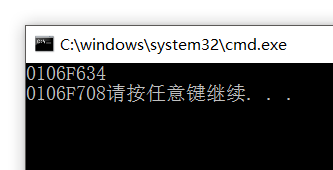先看一个例子:这个程序为什么会崩溃?
1 #include <stdio.h> 2 #include <stdlib.h> 3 4 int f(int *q) 5 { 6 int a = 10; 7 q = (int*)malloc(sizeof(int)); 8 *q = a; 9 return 0; 10 } 11 12 int main() 13 { 14 15 int *p = NULL; 16 f(p); 17 printf("%d", *p); 18 return 0; 19 }
此处的q任然是p的一个拷贝,可以通过这个程序证明:
1 #include <iostream> 2 3 4 int f(int *q) 5 { 6 std::cout << &q << std::endl; 7 return 0; 8 } 9 10 int main() 11 { 12 int a = 10; 13 int *p = &a; 14 f(p); 15 std::cout << &p; 16 return 0; 17 }
输出为: , 说明指针p与指针q的地址是不同的,证明q是p的一个拷贝。
, 说明指针p与指针q的地址是不同的,证明q是p的一个拷贝。
所以第一个程序崩溃的原因:函数中的q其实是实参p的一份拷贝,函数中的操作都是对q进行的,p仍然是NULL,所以输出*p的值产生崩溃!
可以把形参改为二级指针,程序便可以按预想中的情形进行:
1 #include <stdio.h> 2 #include <stdlib.h> 3 4 int f(int **q) 5 { 6 int a = 10; 7 *q = (int*)malloc(sizeof(int)); 8 **q = a; 9 return 0; 10 } 11 12 int main() 13 { 14 15 int *p = NULL; 16 f(&p); 17 printf("%d", *p); 18 return 0; 19 }